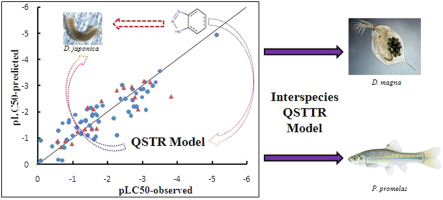Ecotoxicology and Environmental Safety ( IF 6.2 ) Pub Date : 2018-09-22 , DOI: 10.1016/j.ecoenv.2018.09.068 Kazi Amirul Hossain , Kunal Roy

|
The contaminants of emerging concern (CEC) are universally detected in surface water and soil. They can affect the wild life, and their subsequent translocation through the food chain can affect human health, which is an issue of serious concern. Very few amounts of ecotoxicological data are available on the environmental behavior and ecotoxicity of CEC, thus modeling approaches are essential to bridge the existing gap in experimental data. In this present study, we have developed quantitative structure-toxicity relationship (QSTR) models using a data set of 75 compounds for the prediction of aquatic ecotoxicity of CECs on fresh water planarian (Dugesia japonica) by partial least squares (PLS) regression algorithm using simple molecular descriptors selected by genetic algorithm approach. We also explore the correlations between toxicity against D. japonica and those against daphnia (D. magna) and fish (P. promelas), and these were improved on addition of a few molecular descriptors (B08[C-O] and B09[N-O] in case of daphnia and C-006 and H-052 in case of fish) which allowed us to develop predictive interspecies quantitative structure toxicity-toxicity relationship (QSTTR) models, allowing to extrapolate data from one endpoint to another endpoint. The QSTR (Q2LOO ranging from 0.630 to 0.720 and R2pred ranging from 0.723 to 0.798) and QSTTR (Q2LOO = 0.60 and 0.67, R2pred = 0.88 and 0.84) models have desirable statistical qualities and acceptable internal and external validation measures, meeting rigorous criteria of different validation metrics and showing acceptability for regulatory purposes as proposed by Organization for Economic Cooperation and Development (OECD). Consensus predictions were also performed based on multiple models generated in this study by using the “Intelligent Consensus Predictor” (ICP) tool to enhance the prediction quality for external set compounds.
中文翻译:

化学分析模型中的新兴污染(CECs)在日本日惹的污染物的水生毒性及其与水蚤和鱼类的种间相关性:QSTR和QSTTR方法
普遍关注的污染物(CEC)在地表水和土壤中得到普遍检测。它们会影响野生生物,其随后通过食物链的转移也会影响人类健康,这是一个令人严重关注的问题。关于CEC的环境行为和生态毒性的生态毒理学数据很少,因此建模方法对于弥合实验数据中现有的差距至关重要。在本研究中,我们使用75种化合物的数据集开发了定量结构-毒性关系(QSTR)模型,用于预测CEC对淡水planar虫(Dugesia japonica)的水生生态毒性。通过使用遗传算法方法选择的简单分子描述符的偏最小二乘(PLS)回归算法。我们还探索了对日本粳稻和对水蚤(D. magna)和鱼类(P. promelas)的毒性之间的相关性,并通过添加一些分子描述符(B08 [CO]和B09 [NO])改善了这些相关性。案例:水蚤和C-006和H-052(鱼类),这使我们能够建立预测性物种间定量结构毒性-毒性关系(QSTTR)模型,从而可以将数据从一个终点推算到另一个终点。QSTR(Q 2 LOO为0.630至0.720,R 2为pred范围从0.723到0.798)和QSTTR(Q 2 LOO = 0.60和0.67,R 2 pred = 0.88和0.84)模型具有理想的统计质量和可接受的内部和外部验证措施,满足不同验证指标的严格标准,并显示出监管可接受性经济合作与发展组织(OECD)提出的目的。还使用“智能共识预测器”(ICP)工具基于本研究中生成的多个模型进行共识预测,以提高外部化合物的预测质量。

































 京公网安备 11010802027423号
京公网安备 11010802027423号